After a decent night’s sleep the intrepid gang of four awakened in the dark once again, hoping to top the previous day’s birding adventure. From Cranberry Lake, just across the road from our motel, came the haunting calls of Common Loons, amplified by the damp air. The sound was enough to send shivers down my spine, and I can’t think of a better omen at the beginning of a full day of birding.
Our first planned stop was the Upper and Lower Lakes State Wildlife Management Area, a little over an hour’s drive north and west, past the college town of Canton, deep into St. Lawrence County. It was good we had Tom to come up with the route as he had picked back roads to get us there and the beams of our headlights illuminated White-tailed Deer and Snowshoe Hares. A couple of stops to listen for owls along the way brought the distant “Who cooks for you” call of a Barred Owl. Once we reached Canton dawn was breaking and we began to scour the fields west of town in the hopes of finding Sedge Wrens, which would be a year bird for all of us and a lifer for Will.
Of course, the exact field that they had been reported in earlier in the year had been mowed for hay, but we did pick up a “Gray Ghost” better known as a male Northern Harrier, and a singing Savannah Sparrow. Continuing down Irish Settlement Road we listened carefully through open windows, despite the light rain that had begun to fall, hoping to hear the chattery call of our quarry. Finally, success! We heard a Sedge Wren call and after about 15 minutes of examining every little bird that flew over the field we managed to identify a Sedge Wren, the only year bird I would add in a weekend that featured a 100-bird species list. The other main highlight while trying to track down the shy wren was two American Bitterns that gave great looks as they flew into the field to hunt!
Our first stopping place at the Upper and Lower Lakes was a boat launching site from which we saw and heard breeding Pied-billed Grebes, Canada Geese, and Wood Ducks. Distant Black Terns in breeding plumage were a joy to see as they hawked for insects. Marsh Wrens sang their liquid songs from the cattails and a Warbling Vireo sang from a distant treeline.
Our next stop was at the shorter of the two observation towers, and we used the tower to spot Ring-necked Ducks with young, beautiful Black Terns at shorter range, and two other species of tern, Common Terns and a single Caspian Tern. A short walk along a mowed goose-poop littered embankment rewarded me with several Wilson’s Snipe and a magnificent pair of Northern Harriers, the male absolutely dwarfed by the female. We also heard our first and only Yellow Warbler of the day and other species that tend not to be present in the higher elevations we spent most of our weekend in, like Eastern Towhee, Northern Cardinal, and Gray Catbird.
Upper and Lower Lakes SWMA on a gray morning
Our final stop at the productive wildlife management area was the Indian Creek Nature Center, where the second and larger of the two observation towers is located. The walk to the tower was enlivened by a Ruffed Grouse that almost made me soil myself when it erupted from the undergrowth within feet of my feet, a singing Black-and-white Warbler, and the constant presence of the bane of birders, deerflies.
a deerfly that was rewarded for posing by being squished
Once we reached the tower Will spotted a Bald Eagle and we saw many of the previously mentioned species as well. An oddly-plumaged Red-necked Grebe drove us a bit crazy for awhile but we finally figured out what it was.
A quick stop in Canton for refreshments and then we retraced our path back into the Adirondacks, stopping a couple of times to look and listen. We spotted this Chestnut-sided Warbler at a particularly birdy stop that also included the entertaining sight of a Sharp-shinned Hawk chasing off a much larger Red-tailed Hawk.
“pleased pleased pleased to meet you” is the song of this pleasant warbler
Rather than just head home we decided to stop at some bogs we hadn’t visited the day before, hoping against hope that we might finally find some of our much sought after Adirondack specialties. Alas, it was not to be. Sabattis Bog, though, was rather birdy, and with the sun shining strongly again many species of warbler started singing from the woods along the rail trail.
male Black-throated Blue Warbler taking off
Northern Parula diving for cover
I used the two pictures above to try to convey the difficulty we experienced in trying to see, and not just hear, the many species of warbler present at Sabattis. In addition to those pictured above we saw or heard Canada, Nashville, Black-throated Green, Magnolia and Yellow-rumped Warblers, Ovenbirds and Common Yellowthroats. White-throated, Song and Lincoln’s Sparrows represented the family Emberizidae and Cedar Waxwings, Ruby-throated Hummingbirds, Hermit Thrushes and Winter Wrens were just a few of the other species present.
And Sabattis wasn’t just for the birds! Dragonflies were everywhere, as were Red Squirrels, butterflies and a couple snakes.
I’m pretty sure this is just a nicely patterned Garter Snake
We reluctantly left Sabbatis Bog and headed to our last stop of the weekend, the most popular bog for birders in all of the Adirondacks. Yes, I speak of Ferd’s Bog. But once again, Ferd’s Bog was a disappointment. Sure we heard young Common Ravens screaming bloody murder and saw more Lincoln’s Sparrows but other than a few Black-capped Chickadees, a calling Pileated Woodpecker, and some Swamp Sparrows that was about it. Bogs are really meant to be visited early in the day but still…
The long ride home after we parted ways with Tom consisted of Will and I improvising lyrics to Nirvana songs while Jory snoozed in the back seat. I’ll probably make at least one more trip into the Adirondacks before the snow flies but I doubt it will be so memorable.


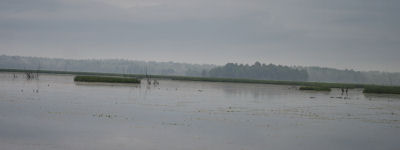
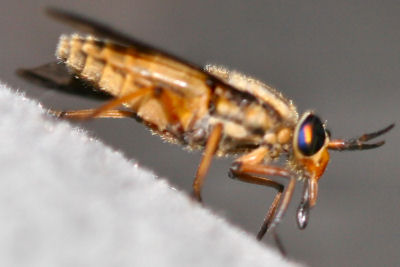
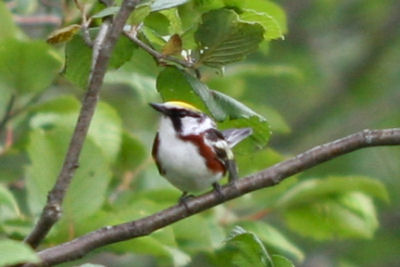
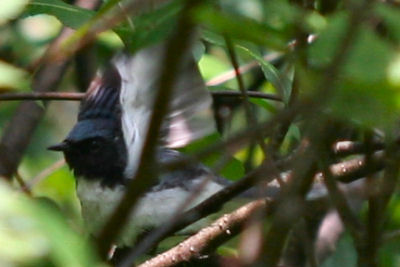
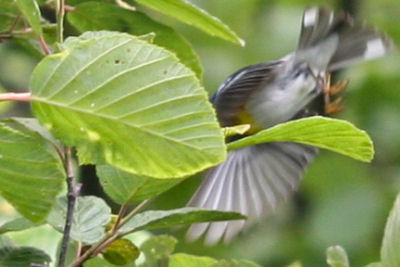
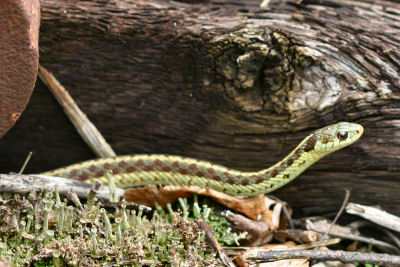











Don’t fool yourself Corey, we will go back again, AFTER the snow flies… And Snow right now, sounds good.
That N. Parula would have made a great quiz bird. Sounds like a real sweet trip!